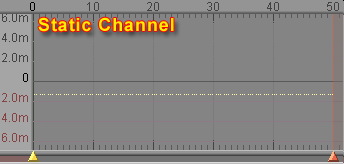|
S t a t i c & D y n a m i c C h a n n e l s |
|---|
Static and
Dynamic channels:
There are two types of channels in
messiah: Static and Dynamic.
Dynamic channels are animatable. If you've used other
animation packages you are, no doubt, quite familiar with dynamic
channels. If you're not familiar with them, the simple
explanation is that they are channels that you can make keyframes
for, and therefore animate. But there may be certain
items/channels that you don't want to be animated. For
example, you might not want to animate the camera's Aperture
Height, or the position of a texture map. So these
channels can be set channels to be Static (some of those
types are already set to Static by default).
When it's set to Static, the channel will have the same
value no matter the current frame. So if you're on frame 30
and you modify the channel, it will modify it for the whole scene,
not just frame 30; in other words, it won't make-- or let you
make-- a keyframe.
![]()
Middle-click to change between Static and Dynamic. (The key icon in the lower one means that there's a keyframe on the current frame; it's not the "Dynamic" symbol. When there's no keyframe on the current frame, there's no key icon, it's just an empty circle.)
Here's what it all looks like in the Motion Graph. The animation below shows a channel as Static then as Dynamic. As you can see, when it is Static you can't make keyframes. If you middle-click, it will set the spline to that value, but it will use that value for the entire animation, not just at that frame. But when it is Dynamic, you can create keyframes and adjust them to your liking. When you middle-click in a Static channel, you will create a keyframe at that value (and left-click will let you adjust the value of a keyframe, and right-click lets you adjust the time).

Static
Channels with Expressions:
Although Static Channels
can't be animated, they can still be controlled by
expressions. So that means they're not static all the
time. I just thought you'd like to know.